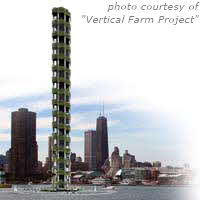VERTICAL FARMING: FARMSCRAPERSDear EarthTalk: What is “vertical farming” and how is it better for the environment?
Jonathan Salzman, New York, NY “Vertical farming” is a term coined by Columbia University professor of environmental health and microbiology Dickson Despommier to describe the concept of growing large amounts of food in urban high-rise buildings—or so-called “farmscrapers.” According to the vision first developed in 1999 by Despommier and his students, a 30-story building built on one city block and engineered to maximize year-round agricultural yield—thanks largely to artificial lighting and advanced hydroponic and aeroponic growing techniques—could feed tens of thousands of people. Ideally the recipients of the bounty would live in the surrounding area, so as to avoid the transport costs and carbon emissions associated with moving food hundreds if not thousands of miles to consumers. 
Pictured: an artist's rendition of what a “farmscraper” might look like.
|
|
“Each floor will have its own watering and nutrient monitoring systems,” Despommier elaborated to online magazine Miller-McCune.com, adding that every single plant’s health status and nutrient consumption would be tracked by sensors that would help managers ward off diseases and increase yield without the need for the chemical fertilizers and pesticides so common in traditional outdoor agriculture. “Moreover, a gas chromatograph will tell us when to pick the plant by analyzing which flavenoids the produce contains,” Despommier said. “It’s very easy to do…These are all right-off-the-shelf technologies. The ability to construct a vertical farm exists now. We don't have to make anything new.” With world population set to top nine billion by 2050 when 80 percent of us will live in cities, Despommier says vertical farming will be key to feeding an increasingly urbanized human race.
His Vertical Farm Project claims that a vertical farm on one acre of land can grow as much food as an outdoor farm on four to six acres. Also, vertical farms, being indoors, wouldn’t be subject to the vagaries of weather and pests. “The reason we need vertical farming is that horizontal farming is failing,” Despommier told MSNBC, adding that if current practices don’t change soon, humanity will have to devote to agriculture an area bigger than Brazil to keep pace with global food demand. Another benefit of vertical farming is that former farmland could be returned to a natural state and even help fight global warming. As agricultural land becomes forest and other green space, plants and trees there can store carbon dioxide while also serving as habitat for wildlife otherwise displaced by development.
Vertical farming is not without critics, who argue that the practice would use huge amounts of electricity for the artificial lights and machinery that would facilitate year-round harvests. Bruce Bugbee, a Utah State University crop physiologist, believes that the power demands of vertical farming—growing crops requires about 100 times the amount of light as people working in office buildings—would make the practice too expensive compared to traditional farming where the primary input, sunlight, is free and abundant. Proponents argue that vertical farms could produce their own power by tapping into local renewable sources (solar, wind, tidal or geothermal) as well as by burning biomass from crop waste. 
CONTACT: The Vertical Farm Project, www.verticalfarm.com
SEND YOUR ENVIRONMENTAL QUESTIONS TO:
EarthTalk®, P.O. Box 5098, Westport, CT 06881; earthtalk@emagazine.com
Read past columns at: www.emagazine.com/earthtalk/archives.php.
EarthTalk® is now a book! Details & order information at: www.emagazine.com/earthtalkbook.
| 